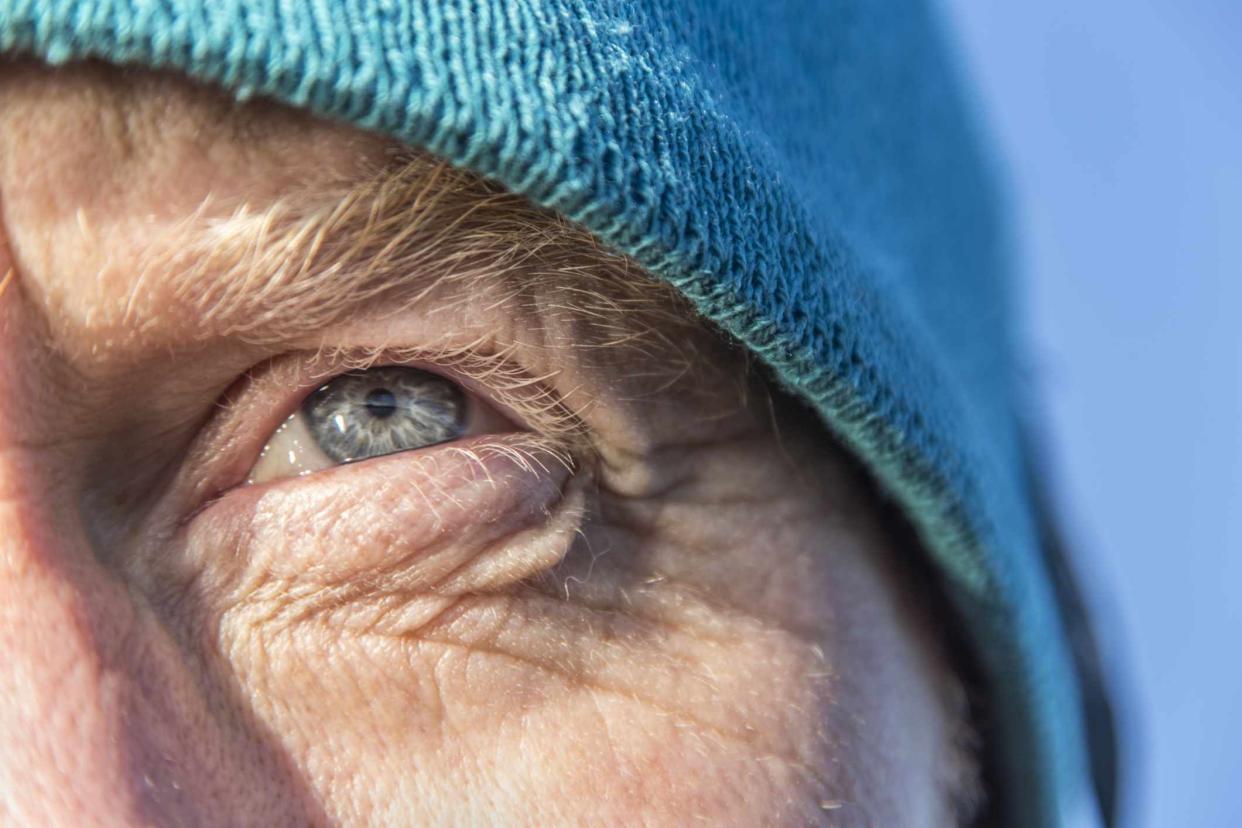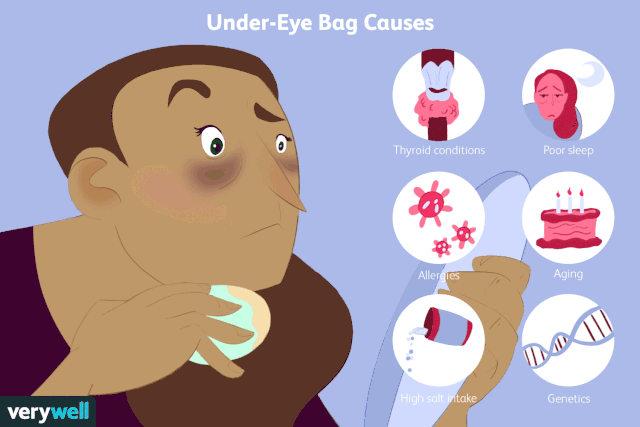What Are Under-Eye Bags?

Getty Images / David Trood
Medically reviewed by Susan Bard, MD
You’re not alone for having bags under your eyes. This skin condition is common—especially as you get older. Under-eye bags can form for many other reasons, too. While sometimes they’re a sign of an underlying condition, having them doesn’t mean there’s something physically wrong with you.
That said, having puffiness or bags around the eyes can make you look sleepy and unwell. Thankfully, there are ways to reduce the look of sagging under-eye skin.

Laura Porter / Verywell
Under-Eye Bag Symptoms
How do you know you have bags under your eyes? Symptoms around the eye include:
Sagging
Swelling
Puffiness
Takeaway
If accompanied by other symptoms, under-eye bags may be a sign of Graves’ disease, which is a thyroid disease that affects the eyes. Other eye-related Graves disease symptoms include pain and redness, eye-bulging, irritation, and dryness. In later stages, the disease can cause vision issues.
Causes
Wondering what causes under-eye bags? They can happen for a number of reasons.
Genetics
Under-eye bags tend to run in families. If your close relatives are prone to developing bags under their eyes, you have a higher risk of developing them, too. In addition, increased vasculature under the eyes, which is sometimes inherited, can create the illusion of darkness.
Age
Aging is one of the most likely causes of bags under the eyes. As you age, your skin loses elasticity and succumbs to gravity. In your eye area, the fat tends to shift around the lower eyelids, creating a puffy, swollen appearance.
Lifestyle
Certain habits can also increase your risk of developing under-eye bags. Poor sleep, smoking, and high salt intake can contribute to the formation of under-eye bags.
Allergies and Thyroid Conditions
Thyroid conditions—both hyperthyroidism and hypothyroidism—can cause under-eye bags or circles. Treating these conditions will often help improve your eyes' appearance.
Allergies that produce nasal or sinus congestion will also increase puffiness around the eyes. Congestion can cause blood to pool in the capillaries underneath the eyes, leading to puffiness and dark circles called allergic shiners. To prevent swelling and puffiness in the eye area, you can try to stay away from allergens as much as possible.
Preventing Under-Eye Bags
While you can’t reverse the aging process, you can do a few things to prevent bags from forming under your eyes:
Take care of your skin by applying sunscreen daily. Skipping sunscreen can lead to skin damage, which weakens the skin and makes it more prone to premature sagging. If you use only one skincare product for the rest of your life, it should be sunscreen.
Eat a healthy, low-salt diet if you’re prone to retaining fluids. This can help prevent puffiness.
Improve the quality of your sleep. There are many things you can do to improve sleep hygiene so you have a better chance of getting enough sleep. Diagnosing and treating sleep apnea and other sleep disorders can reduce serious health risks.
Quit smoking. Not only does smoking contribute to under-eye bags, but it ages the skin prematurely, leading to wrinkles.
Diagnosis
Under-eye bags are usually self-diagnosed. You don’t typically need to see a doctor unless you suspect an underlying issue like thyroid disease, allergies, or a sleep disorder. It is also good to see a doctor or dermatologist if your under-eye bags or dark circles are bothering you and making you feel self-conscious.
If your eye area feels itchy, hot to the touch, or painful, and the problem doesn’t seem to be clearing up, see a doctor to rule out an infection or another diagnosis.
Treatment
Here are some of the available treatment options to get rid of under-eye bags.
Home Remedies
A cold compress is a handy solution for dealing with occasional under-eye swelling and puffiness. Cooling limits swelling and reduces the appearance of tired eyes. Grabbing an ice pack is a quick and easy way to treat this condition at home. There’s also evidence that putting green or black tea bags under the eyes may help reduce inflammation.
Topical Treatments
Caffeine-infused creams and hemorrhoid treatments can both help if applied directly to the skin under the eyes. You should be very careful when using anything around the eye area, since the skin around the eyes and the eyes themselves are sensitive. However, these kinds of topicals can be effective in reducing swelling.
Skin Lightening
A skin-lightening treatment, like hydroquinone, is helpful only for post-inflammatory hyperpigmentation, which isn't usually a cause of under eye circles. However, a vitamin C serum may brighten skin as well as encourage collagen growth and reduce wrinkles, improving the look of skin around the eye area.
Lifestyle Changes
A few targeted lifestyle changes can help reduce the appearance of under-eye bags. These include:
Getting enough sleep
Limiting salt intake
Avoiding fluids before bed
Sleeping with your head slightly elevated
Avoiding allergens
Quitting smoking
Non-Invasive Medical Treatments
If other methods haven't provided relief, consider these non-invasive treatment options for dark circles or puffiness.
Laser: This involves lasering the area to remove layers of skin and encourage cell growth. It’s a long-lasting treatment that helps firm up skin.
Radiofrequency: Instead of a laser, this treatment utilizes an electric current to tighten the skin.
Intense pulsed light: This treatment helps get rid of hyperpigmentation for an even skin tone.
Fillers: Injecting the under-eye area with dermal fillers helps smooth out the area beneath the eyes.
Chemical peel: This method also removes layers, but via a chemical solution rather than laser. It results in skin that is brighter and more taut.
Surgery
Cosmetic surgery to reduce under-eye bags is called blepharoplasty (eyelid surgery). It involves lifting and tightening the skin in the under-eye area to create a smooth look. Though any surgery entails risks, blepharoplasty typically produces lifelong results.
Takeaway
You can also use makeup to conceal dark under-eye circles and puffiness. While cosmetics won’t get rid of sagging under the eyes, they can reduce the appearance of shadows cast by baggy skin.
A Word From Verywell
No one enjoys looking in the mirror and seeing bags under their eyes. While under-eye bags are a fact of life for many people, there are treatment options to help you reduce their appearance. Lifestyle changes can help if the bags under your eyes are caused by sleep deprivation or poor diet.
If your under-eye bags are the result of aging and they’re making you feel self-conscious, you can choose from non-invasive and invasive treatment options. Many non-invasive treatments for sagging skin under the eyes provide long-lasting results. If you’re interested in something more permanent, surgery may be the answer.
Most of the time, under-eye bags are nothing to worry about. Sure, they’re annoying, but they don’t usually point to underlying health problems. If you have concerning symptoms or experience discomfort around the eye area, however, get in touch with a medical professional.

